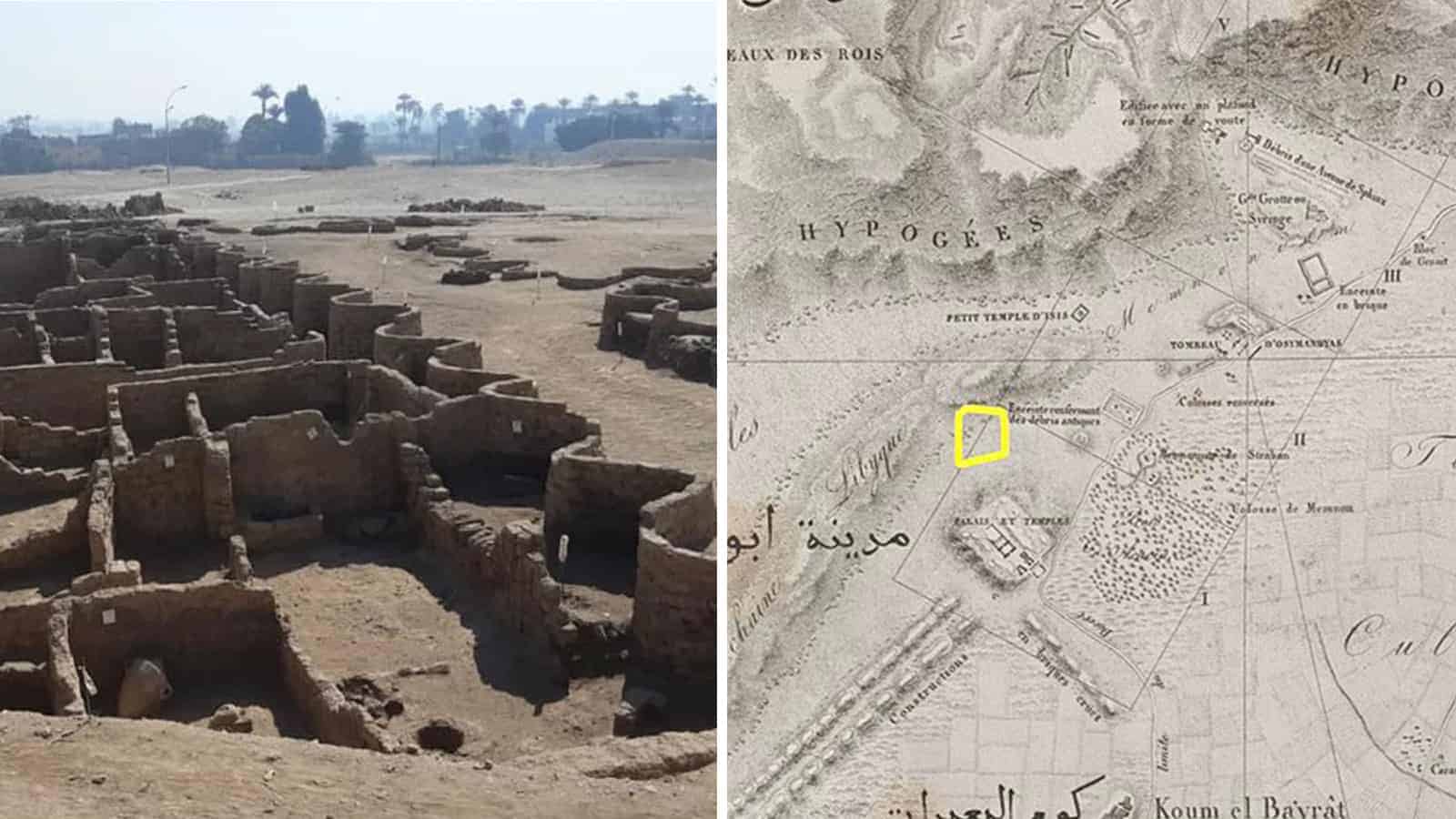Late last year, archaeologists made a surprising discovery – a 3,000-year-old Egyptian lost city buried beneath the sand. They call it the second-most important discovery since the opening of King Tut’s tomb in 1922. The team discovered this lost city close to the world-famous Valley of the Kings.
Archaeologists began the excavation about 300 miles south of Cairo, Egypt, in September 2020. It didn’t take long before the team uncovered vast mud and brick formations zigzagging in all directions.
Renowned Egyptologist and former antiquities minister Dr. Zahi Hawass announced the incredible discovery on Facebook. He said the ruins of the lost city were uncovered near Luxor, home of the ancient pharaohs.
The discovery of the ancient Egyptian city near Luxor has captivated the world, shedding light on a bygone era with remarkable detail. As archaeological teams continue to unearth the site’s secrets, the role of excavation contractors becomes crucial in ensuring that the excavation process is conducted with precision and care.
Such contractors are essential in managing the complex logistics of large-scale digs, including the careful removal of sediment and preservation of delicate artifacts.
In this context, companies like Franky’s Excavation are pivotal, providing specialized services that facilitate thorough and efficient excavation work. Their expertise ensures that every layer of soil is meticulously handled, helping archaeologists maintain the integrity of the site while uncovering invaluable historical treasures. As the excavation of this ancient city progresses, the involvement of such skilled contractors will undoubtedly play a key role in bringing more of Egypt’s rich history to light.
The lost city: Dazzling Aten
 Called “Dazzling Aten,” it’s the most significant ancient city in Egypt identified by archaeologists to date. The lost city dates back to the reign of Amenhotep III, one of the greatest rulers of Egypt throughout history. He founded the city and ruled Egypt along with his son Akhenaton from 1391 to 1353 BCE. Hawass described the city as well-preserved, with walls nearly complete and “with rooms filled with tools of daily life.”
Called “Dazzling Aten,” it’s the most significant ancient city in Egypt identified by archaeologists to date. The lost city dates back to the reign of Amenhotep III, one of the greatest rulers of Egypt throughout history. He founded the city and ruled Egypt along with his son Akhenaton from 1391 to 1353 BCE. Hawass described the city as well-preserved, with walls nearly complete and “with rooms filled with tools of daily life.”
“Many foreign missions searched for this city and never found it,” he said. “We began our work searching for the mortuary temple of Tutankhamun because the temples of both Horemheb and Ay (two other powerful pharaohs during that time) were found in this area.”
Archaeologists reveal Aten was the most significant administrative and industrial settlement on the western bank of Luxor during the Egyptian empire.
‘The city’s streets are flanked by houses, which some of their walls are up to 3 meters high,’ Hawass continued, ‘we can reveal that the city extends to the west, all the way to the famous Deir el-Medina.’
Archaeologists discovered plentiful buried treasures in the city’s ruins.
Since excavations began between the temples of Ramses III and Amenhotep III, archaeologists have found ‘tombs filled with treasures.’ They’ve found several neighborhoods, including a bakery equipped with ovens and pottery for storage in the southern area. They believe that the kitchen employed many workers who catered to significant events, like festivals.
The team also found evidence of larger, more organized administrative and residential districts protected by a zigzagging wall. Since these districts had a single entry point, archaeologists believe city officials wanted to control access, keeping the area secure. The zigzag walls were not a common feature in the architectural elements of ancient Egypt. They mainly appeared in structures toward the end of the 18th dynasty.
Interesting finds
In another of the city, archeologists found evidence of a workshop. One side of the workshop housed a production area for mud bricks used to build temples. Archaeologists unearthed artifacts from craftsmen such as jewelers, brickmakers, and glazers as well. Evidence of their work appeared in mud bricks bearing the seal of Amenhotep III. These very bricks likely helped build several nearby temples, like the Temple of Ramses II.
The team also uncovered a vessel containing 2 gallons of dried or boiled meat (about 10 kg). It had the following inscribed on the outside: ‘Year 37, dressed meat for the third Heb Sed festival from the slaughterhouse of the stockyard of Kha made by the butcher luwy.’
This priceless discovery reveals the names of two people who called the city their home. Not only that, but it proves that the city dates back to the reign of King Amenhotep III and Akhenaten.
Furthermore, the excavation uncovered a mud seal with the inscription “gm pa Aton,” translated as “the domain of the dazzling Aten.” Hawass said that King Akhenaten named a temple at Karnak ‘Dazzling Aten.’
 Archaeologists hope to uncover more about this fascinating period in Egyptian history.
Archaeologists hope to uncover more about this fascinating period in Egyptian history.
The northern part of the city revealed a cemetery, but the team doesn’t yet know the extent and preservation. Stairs carved into the rock pave a path to the rock-cut tombs scattering the graveyard. Graves in the nearby Valley of the Kings have similar construction.
“Work is underway, and the mission expects to uncover untouched tombs filled with treasures,” says Hawass.
Al Jazeera reports that treasures such as Hawass describes have already been uncovered. Archaeologists have found items such as jewelry, pottery, and scarab pendants so far. Inscriptions on some artifacts tell a story about this critical period in history.
Betsy Brian, a professor of Egyptology at Johns Hopkins University, said the following:
“The discovery of the Lost City not only will give us a rare glimpse into the life of the Ancient Egyptians at the time where the Empire was at his wealthiest but will help us shed light on one of history’s greatest mystery: why did Akhenaten and Nefertiti decide to move to Amarna.”
One fact about this period in Egypt still puzzles historians. Amenhotep III’s son Akhenaten moved the capital to Amarna after he died. Historians don’t know why this occurred, but Hawass and other archaeologists hope further excavations will reveal the answer. They also want to know if the city was repopulated when Tutankhamen later moved the capital to Thebes. The inscription on the pot containing dried meat said ‘Year 37,’ a year before the citizens abandoned Aten.
As archaeologists continue excavations, we’ll likely have a much better understanding of this fascinating period in Egyptian history. The discovery could also help revitalize the tourist industry in Egypt after years of political unrest.
Final thoughts about this ancient lost city in Egypt recently discovered by archaeologists
A team of archaeologists recently uncovered the 3,000-year-old city of Aten in ancient Egypt. So far, they’ve found evidence of residential districts, a bakery, a cemetery, and a considerable workshop used for the production of bricks. Artifacts unearthed include pottery, scarab pendants, jewelry, and tools used in daily life. In the months to come, the team hopes to understand more about the events that unfolded 3,500 years ago.
The ongoing excavations could perhaps revamp tourism in Egypt, as recent events have deterred visitors. The unexpected discovery makes history and will give us a glimpse into life in ancient Egypt.

















